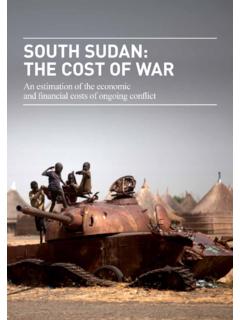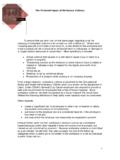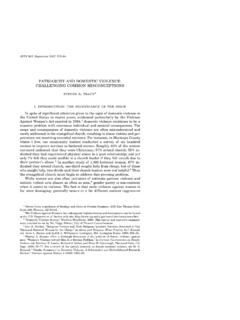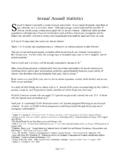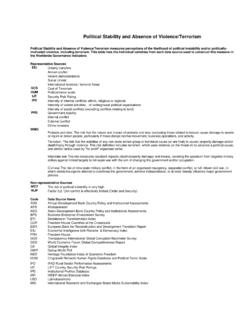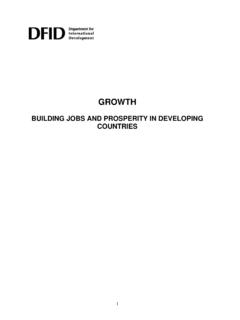Transcription of Economic Fact Sheet - markhaden.com
1 Economic Fact Sheet Facts and Figures Relating To Illegal Drugs Canada spends $ billion on enforcement (police, courts and corrections), and billion in direct health care costs every year, dealing with illegal drugs. Source: J. Rehm, et al. (2006). The Costs of Substance Abuse in Canada-2002. Canadian Centre on Substance Abuse. Canada spends more than $4 on enforcement for every $1 spent on the health response in dealing with illegal drugs. ($ million vs $88 million) $1 spent on treatment will achieve the same reduction of flow of cocaine as $ spent on enforcement.
2 $1 spent on treatment will achieve the same reduction of flow of cocaine as $ spent on border control. $1 spent on treatment will achieve the same reduction of flow of cocaine as $23 spent trying to persuade Colombian farmers to grow crops other than coca. In parts of South America, some illegal drug firms command more resources than some governments. Drug law, apparently ineffective in reducing consumption, is highly effective in increasing the price of drugs. Federally, 11 departments and agencies spend approximately $500 million annually to address illicit drug use in Canada.
3 Since 1997, most of the government's legislative changes related to illicit drugs have focussed on supply reduction (enforcement), not demand reduction. Source: Single, E., et al. (1996). The Costs of Substance Abuse in Canada. Canadian Centre on Substance Abuse. Source: Rydell, C. P., Caulkins, J. P., & Everingham, S. S. (1996). Enforcement or treatment? Modeling the relative efficacy of alternative for controlling cocaine. Operations Research (RAND), 44(5), 687-695. Source: Stevenson, R. (1998, April). Costs of the war on drugs. Paper presented at the conference Sensible solutions to the urban drug problem , sponsored by the Fraser Institute, Vancouver, Canada.
4 While estimates vary, the United Nations believes that the annual global sales of illicit drugs are between $450 billion and $750 billion. In Canada, the government's estimates of sales range from $7 billion to $18 billion. Page 1 For the roughly 50,000 persons charged, 90 percent of the charges related to cannabis and cocaine. Cannabis accounted for over two thirds of the charges, and about half of all charges were for possession. An estimated 125,000 people in Canada inject drugs. (In Canada) the Economic costs, including health care (for example, HIV/AIDS and hepatitis), lost productivity, property crime, and enforcement are estimated to exceed $5 billion annually.
5 In Vancouver, for example, an estimated 70 percent of criminal activity is associated with illicit drugs. About 63 percent of federal offenders have drug abuse problems. A major concern in Canada is the relationship between drugs, organized crime, and violence. A 1998 federal government study of organized crime concluded that the drug trade has a significant impact on Canadians and entails substantial violence. Furthermore, with drugs as its primary source of revenue, organized crime has intimidated police officers, judges, juries, and correctional officers.
6 Such intimidation is a direct threat to Canada's philosophy of peace, order, and good government. Of note is that more than 150 deaths since 1994 have been attributed to "biker" wars in Quebec over control of organized crime, including the illicit drug trade. Illicit drugs also represent a source of income for terrorist groups. The United Nations has expressed deep concern about the links between terrorist groups and illicit drug production and trafficking. Customs intercepts illicit drugs entering Canada at our borders. For instance, it estimates that in 1999 it seized illicit drugs with a street value estimated at $351 million.
7 The largest cost of CSC (Correction Service Canada) is incarceration. The most serious offence by 17 percent (3,400) of its offenders is drug-related. CSC estimates that about 7 percent of its offenders are associated with organized crime. Substance abuse is one of seven criminogenic factors contributing to criminal behaviour. Nearly two thirds of offenders entering the federal corrections system have drug abuse problems. An estimated 53 percent of offenders participate in substance abuse programs while serving their sentences. About 95 percent of the federal government's expenditures that address illicit drugs were used for supply reduction (enforcement or interdiction).
8 Source: Illicit Drugs: The Federal Government s Role. Office of the Auditor General of Canada. (2001). The international illicit drug business generates as much as $400 billion in trade annually according to the United Nations International Drug Control Program. That amounts to 8% of all international trade and is comparable to the annual turnover in textiles. Source: United Nations Office for Drug Control and Crime Prevention, Economic and Social Consequences of Drug Abuse and Illicit Trafficking (New York, NY: UNODCCP, 1998), p. 3. Page 2 In 1992, the Canadian Centre on Substance Abuse estimated that the cost of substance abuse was more than $ billion, representing $649 per capita, or about of the Canadian Gross Domestic Product.
9 The Economic costs of illicit drugs in Canada were estimated at $ billion or $48 per capita in 1992, approximately $823 million was lost in productivity due to illness and premature death . In 1992, the cost of illicit drugs to the British Columbia economy was $207 million or $60 per capita. During the same period, the number of deaths per capita from illicit drug use was per 100,000 (which was the highest of any province). Studies by the National Institute on Drug Abuse in the US have estimated that in 1991, the costs to society of an untreated heroin user on the street was US$43,000 and the cost of keeping the individual in jail or in a drug-free program were US$34,000 and US$11,000 respectively.
10 The cost of one year of methadone maintenance treatment was only US$2,400. The Lindsmith Centre, also using US estimates, claims that only 5 to 10% of the cost of MMT actually pays for the medications itself, consequently methadone could be prescribed and delivered even less expensively . Source: Transformation Solutions, Ltd. (2001, June). Review of methadone services in Vancouver/Richmond health region. Vancouver, Canada: T. Turner. According to the United Nations, profits in illegal drugs are so inflated, that three-quarters of all drug shipments would have to be intercepted to seriously reduce the profitability of the business.
